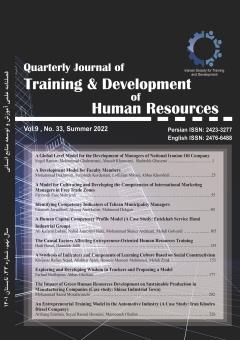-
-
List of Articles
-
Open Access Article
1 - Providing a World Class Model for National Iranian Oil Company Manager's Development
Sogol Ranvar Mohammad Ghahramani Abasalt Khorasani shahrokh ghasemi -
Open Access Article
2 - Designing and validating the growth model of faculty members
Mohammad bakhtiyari fereshteh kordestani lotfollah abbasi Abbas Khorshidi -
Open Access Article
3 - Provide a model for nurturing and developing the competencies of international marketing managers in free trade zones
Farzaneh Zare Mehrjerdi -
Open Access Article
4 - Identifying indicators of managerial competency in different companies of Tehran Municipality
fatemeh javadifard Alireza Amirkabiri mahmood dehgan -
Open Access Article
5 - DESIGNING a PROFILE of HUMAN CAPITAL COMPETENCY (CASE STUDY: TECNICIANS and CALL CENTERS STAFFS of ENTEKHAB SERVICE INDUSTRIAL GROUP).
Ali Kafami Ladani nahid Amrolahi Biuki Mohammad Shaker Ardakani Mehdi Golverdi -
Open Access Article
6 - Identifying the causal factors affecting the training of entrepreneur-oriented human resources from the perspective of managers and educational policy makers
hadi barati hamideh jalili -
Open Access Article
7 - Synthesis of indicators and components of learning culture based on social constructivism
Khojaste Rafi Nejad Aliakbar ajam Hossein momenimahmouei Mehdi zirak zirak -
Open Access Article
8 - Wisdom analysis to develop it in training staff and model presentation
Farhad Shafiepour Motlagh Abbas Hgoltash -
Open Access Article
9 - Investigating the Impact of Green Human Resources Development on Sustainable Production in Manufacturing Companies (Case Study: Shiraz Industrial Town)
Mohammad Saeed Mozafari Mehr -
Open Access Article
10 - Designing of an entrepreneurial educational model in the automotive industry: Iran khodro diesel
arzhang ezatinia sayed rassul hosseini Masome Oladian
-
The rights to this website are owned by the Raimag Press Management System.
Copyright © 2017-2026







